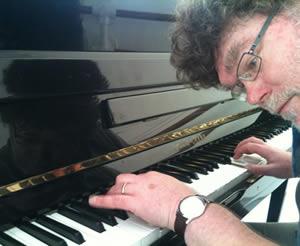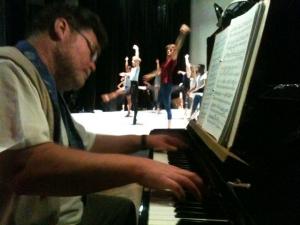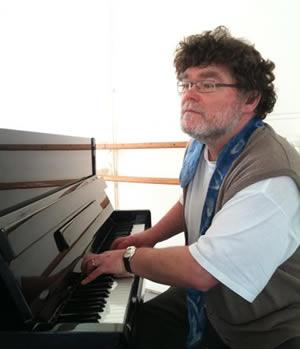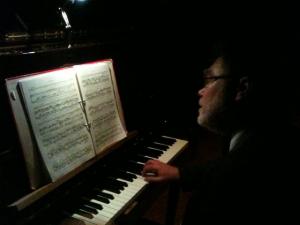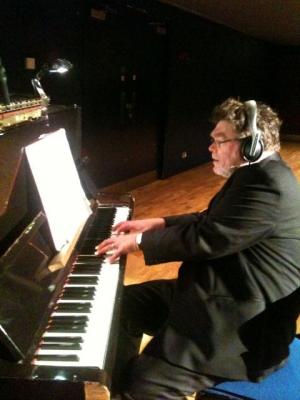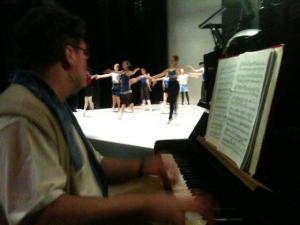Accompanist
Philip Feeney was first exposed to playing for dance at Teatrodanza di Roma under the auspices of Elsa Piperno and Joseph Fontano. The dance language was very much Graham-based, and very inspirational for a young musician in search of a voice. On his return to London, Philip took up the post of musical director of Ballet Central, where he has been composer-in-residence and company pianist and performer for their annual National Tour ever since. Alongside this, he has been a longstanding and influential accompanist at the Place, playing regularly both for the London Contemporary Dance School and the Evening School, and occasionally (too rarely!) for the Richard Alston Dance Company. Moreover he has worked with many visiting companies to London both at Sadlers Wells Theatre, including Northern Ballet Theatre, Carlos Acosta, The White Oak Project, and Ballet Gulbenkian, and at the Barbican Theatre with the Michael Clark Company, Fabulous Beast, and the Martha Graham Company. He has also played and accompanied class for companies who are resident in London, such as Rambert Dance Company, Adventures in Motion Pictures and DV8.
While undoubtedly Feeney has been influenced by the other fine accompanists he has had the pleasure of working alongside, in particular Antonio Coppola, John Sweeney, and John Millar (Jhalib), it has been the outstanding teachers and choreographers that he has worked with who have been the most formative influences in his playing. In Italy he learnt how to respond to movement and how to structure music that is appropriate for dance under the nurturing gaze of choreographer and teacher, Elsa Piperno, and was at this time fortunate to work with visiting international guest teachers such as Doris Rudko, Mary Hinkson and William Louther, with whom Philip was to work both as pianist and composer later in London.
Furthermore in London he was privileged to work with some of the greats of Twentieth Century Contemporary Dance who were then currently teaching at the Place, bringing their wealth of experience to the London dance world; inspirational figures such as Nina Fonaroff, Jane Dudley, Viola Farber and, of course, Robert Cohan, the Founding Artistic Director of the Place. At the same time he came to collaborate with major figures in the Classical Ballet world, in particular, Christopher Gable, Brenda Last, Ronnie Emblen and Murray and Nancy Kilgour.
Philip has developed a very personal style of accompaniment that owes a lot to having begun his career not as a ballet pianist but by playing for contemporary dance, with its non-reliance on pre-existing music or pre-existing dance forms, and its emphasis upon parallel phrasing. So when he began to develop a language for the accompaniment of ballet, his interpretation of it underwent the same process and responded to the same criteria. He found it was important that the music should fit the exercise, should mirror its phrasing and accurately reflect its kinetic qualities. Above all it was imperative that the music should make sense as pure music, and that it made the dancers listen and respond to it.
To Feeney, reflecting both Christopher Gable and Jane Dudley, it was illogical to train dance-artists with inferior or bland featureless music, which could only conceivably create bland and featureless dancers. The music should in that instance seem like it is the only possible music that could accompany that particular dance sequence. Of course, that is not the case; the same exercise can be done to an entirely different piece of music the next day, but at that moment in time there should be a rich and intense connection between the movement and its accompaniment – a parallel adventure, music made visible.
This is helped by the huge range of musical styles that Feeney is able to co-opt into his dance accompaniment, springing no doubt not only from a penchant for classical improvisation but also from his university years spent in a blues and a trad jazz band. Involvement in theatrical productions, at Cambridge and later in Italy, including both a period as a rep pianist for Opera in Rome and as a silent movie accompanist, had alerted him to the theatrical possibilities of getting the right music regardless of style or genre, and helped to remove any stylistic inhibitions.
He remembers a guest lecture by Sir Michael Tippett in Cambridge in which the composer bravely asserted that he never took stylistic considerations into account in his music, a philosophy that echoes Kazuko Hirabayashi’s emphasis upon substance rather than style. Moreover Feeney’s concern for a reciprocal duality between music and choreography was confirmed by his work with hip-hop choreographer, Jonzi D, where synchrony proved to be everything and chance, in a Cage/Cunningham sort of way, was an abnegation of control and overrated! As Christopher Gable used to say, it is “choice not chance” that matters.
Philip is a frequent contributor to international workshops and intensive dance courses, both in the UK and abroad. In the nineties, Philip collaborated with Jane Dudley on a creative choreography course for Birmingham Royal Ballet, and with Robert Cohan on a composition programme for the Place Summer Course. Since about that time he has regularly teamed up with the great Graham teacher, Kazuko Hirabayashi, accompanying her courses both in Japan, and in Spain most recently with Sarah Stackhouse. He also served on the panel with Hirabayashi in 2004 for the International Choreographic Competition in Burgos. It was for Kazuko that Philip played his longest class in Niigata in 1999; a three and a half hour Graham class was immediately followed by a four hour class – a two day course had been condensed into one, but Kazuko was determined that her students should not lose out.
As well as being composer for some of the celebrated Fabulous Beast productions, Philip has also frequently supported Michael Keegan-Dolan in his creative workshops in Shawbrook School of Dance, and more recently in Dublin and at the Barbican Centre in London. He also undertook the enjoyable (if challenging) task of playing the Rite of Spring at the Black Box Theatre in Galway during the creative period of Michael Keegan-Dolan’s production for English National Opera’s 2009 season.
For over twenty years he has played on workshops and courses with many of the top teachers in the UK, in particular, working with the renowned teacher and current ballet mistress for Christopher Wheeldon, Jackie Barrett, both in Japan and on the Norfolk Dance Association Summer School, for whom he also wrote two scores.
He continues to play for dance in London, for Ballet Central and at the London Contemporary Dance School, and is currently working on preparing the 2020 Ballet Central National Tour, featuring his score for a new work by Scottish Choreographer in residence, Sophie Laplane, George(ette).
